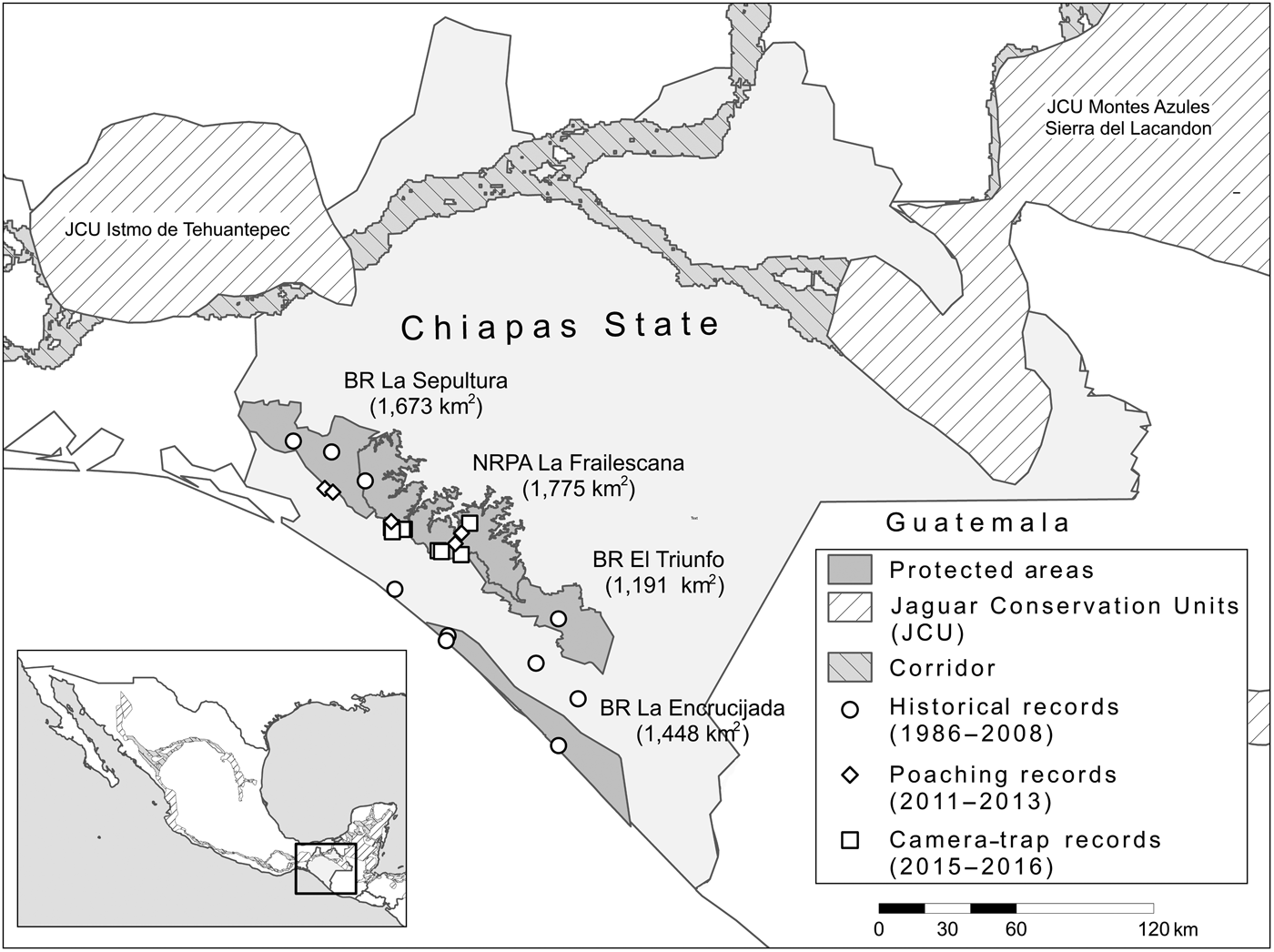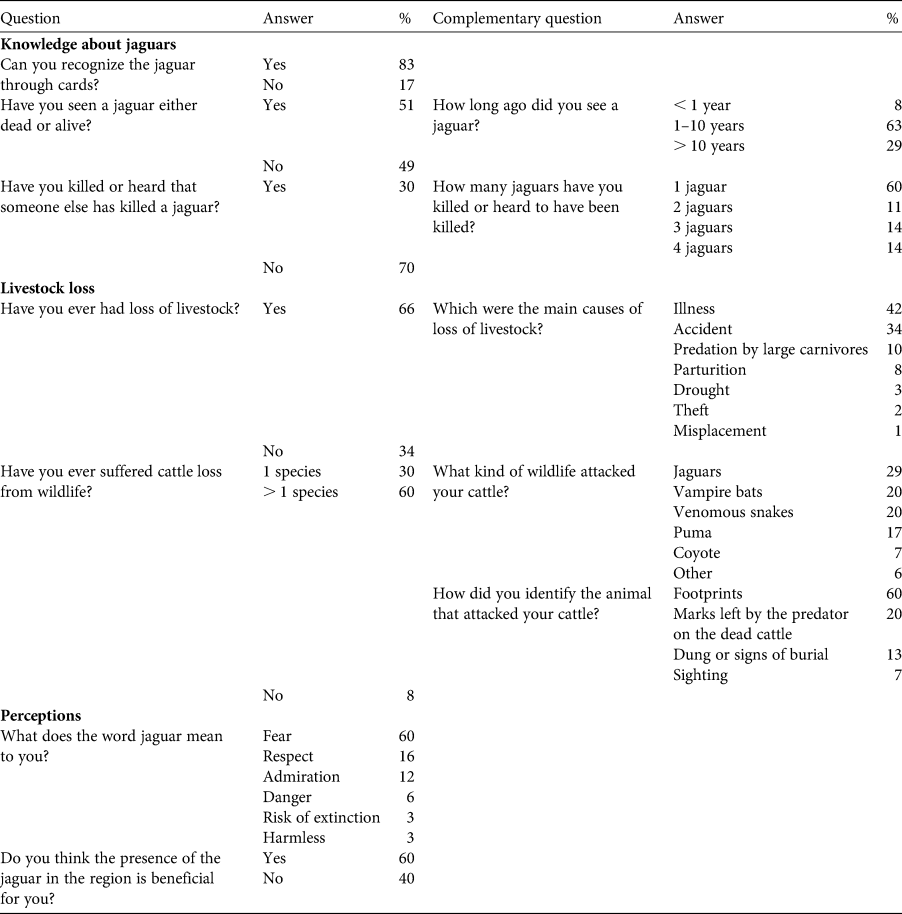Although the jaguar Panthera onca, categorized as Near Threatened on the IUCN Red List (Quigley et al., Reference Quigley, Foster, Petracca, Payan, Salom and Harmsen2017), ranges from the south-west USA to central Argentina, populations outside Amazonia are generally small and isolated (de la Torre et al., Reference de la Torre, González-Maya, Zarza, Ceballos and Medellín2018). One such area, the Sierra Madre de Chiapas in the state of Chiapas, Mexico, is potentially an important area for jaguar conservation but information on the species in this region is limited. To provide information for Mexico's National Jaguar Conservation Strategy, we document here the occurrence and abundance of the species in this region.
The Sierra Madre de Chiapas (Fig. 1) is one of the most biodiverse regions in Mexico, with tropical rainforest, montane cloud forest, pine–oak forest, and tropical deciduous forest (Pérez-Farrera et al., Reference Pérez-Farrera, Meléndez-López, Sarmiento, Moreno and Najarro2006). The complex of the Sierra Madre de Chiapas comprises the Natural Resources Protection Area La Frailescana (1,775 km2) and two Biosphere Reserves, El Triunfo (1,191 km2) and La Sepultura (1,673 km2). The terrain is rugged and steep, with altitudes of 280–2,600 m. Climate is tropical to subtropical, with a rainy season in May–October. Mean annual temperatures are 22–26°C, and mean annual rainfall is 1,200–2,000 mm at mid–low altitudes and 4,000 mm at the highest altitudes.

Fig. 1 Protected areas of the Sierra Madre de Chiapas landscape (Biosphere Reserves (BR) La Sepultura, El Triunfo and La Encrucijada, and Natural Resources Protection Area (NRPA) La Frailescana), jaguar Panthera onca records in this region, and Jaguar Conservation Units and the network of jaguar corridors modelled for the region (Rabinowitz & Zeller, Reference Rabinowitz and Zeller2010).
We compiled all available historical records for the species in the region from the National System of Information on Biodiversity. Additionally, we include confirmed records of individuals that were poached and confirmed records of jaguar signs. To document the jaguar's current presence in the region we deployed 55 camera-trap stations during August 2015–December 2016 in c. 420 km2 of the Natural Resources Protection Area La Frailescana. Camera traps were installed at a height of 40 cm from the ground and distances between camera-trap stations were 385–3,373 m (mean distance 1,073 ± SD 753 m). Total sampling effort was 9,274 trap-days. Individual jaguars detected were identified in the images and videos by the pattern of their pelage (Silver et al., Reference Silver, Ostro, Marsh, Maffei, Noss and Kelly2004).
To make a rapid assessment of the perception of the jaguar by the local communities and to obtain information on any jaguar predation on domestic animals, we interviewed 102 cattle owners in the Natural Resources Protection Area La Frailescana. We used a semi-structured questionnaire with three sections: knowledge about jaguars, cattle loss and perceptions (Table 1).
Table 1 Percentage of responses (of 102 cattle owners interviewed) to questions regarding knowledge about jaguars, the main causes of livestock loss, and perceptions about jaguars in the Natural Resources Protection Area La Frailescana (Fig. 1).

We obtained 11 records of jaguars for 1986–2008 (Muñoz & March, Reference Muñoz Alonso and March Mifsut2003; Lorenzo Monterrubio et al., Reference Lorenzo Monterrubio, Bolaños Citalán and Barragán Torres2005; Morales Pérez, Reference Morales Pérez2005; Fig. 1), at altitudes of 0–1,632 m in the Sierra Madre de Chiapas region and the neighbouring coast of Chiapas (Fig. 1), which was originally tropical rainforest and mangroves but is now mostly deforested (Aranda, Reference Aranda1996). We obtained four confirmed records of jaguars killed, three in retaliation for predation of domestic animals in 2012–2013 and one poached in 2011. Jaguar capture rate across all camera stations was 0.97 per 1,000 trap-days. We identified three male and two female jaguars, and we recaptured three of these individuals. These records were over 1,120–1,758 m, from montane cloud forests and oak forests.
The interviews indicated that the jaguar is well known. More than half of the interviewees had either seen dead jaguars or observed them in the wild, and most of the interviewees had lost some cattle. However, only 10% of these losses were attributed to predation by large felids; 77% were a result of illness or accidents. Jaguars were the main species identified as the predator of cattle (29%) but other wildlife also caused significant loss (40%; Table 1). Although the interviewees considered the jaguar's presence beneficial for ecosystem functioning, many people felt that jaguars were the predator mostly responsible for their loss of cattle (Table 1).
A landscape strategy for jaguar conservation in the Sierra Madre de Chiapas would need to include areas with suitable jaguar habitat, such as the coast of Chiapas, which includes the Encrucijada Biosphere Reserve and adjacent areas of primary forest (Aranda, Reference Aranda1996). Considering the large spatial requirements of jaguars (de la Torre et al., Reference de la Torre, Núñez and Medellín2017) it is likely that individuals are moving between the Sierra Madre de Chiapas and adjacent areas (Fig. 1). This complex, together with the Encrucijada Biosphere Reserve and adjacent areas, encompasses c. 5,500 km2 of primary forest, sufficient to maintain a population of jaguars (Rodríguez-Soto et al., Reference Rodríguez-Soto, Monroy-Vilchis, Maiorano, Boitani, Faller and Briones2011). However, the limited number of historical records that we located indicates that the jaguar population in this region is sparse, and our camera-trap survey indicates that abundance in the region is low compared to other areas in Central America (Silver et al., Reference Silver, Ostro, Marsh, Maffei, Noss and Kelly2004; de la Torre & Medellín, Reference de la Torre and Medellín2011; Chávez et al., Reference Chávez, Zarza, de la Torre, Medellín, Ceballos, Medellín, de la Torre, Zarza, Chávez and Ceballos2016).
International jaguar conservation strategies have not previously included the Sierra Madre de Chiapas (Fig. 1), and the region was excluded from the Jaguar Conservation Units and corridors that were defined to establish continental priorities to conserve the species (Sanderson et al., Reference Sanderson, Redford, Chetkiewicz, Medellin, Rabinowitz, Robinson and Taber2002; Rabinowitz & Zeller, Reference Rabinowitz and Zeller2010). Our results indicate that the species is still present in the region, and we have therefore included the Sierra Madre de Chiapas in Mexico's National Jaguar Conservation Strategy (CONANP, 2009; Zarza et al., Reference Zarza, Chávez, Ceballos, Castaño-Uribe, González-Maya, Zárrate-Charry, Ange-Jaramillo and Vela-Vargas2013; Ceballos et al., Reference Ceballos, Zarza, Chávez, González-Maya, Aguirre and Sukumar2016), and we recommend that international organizations include this area in their priorities for jaguar conservation.
We found that local perceptions of the jaguar included fear and respect, and jaguars were considered harmful and dangerous, but most interviewees believed that the jaguar should be preserved. Although most cattle owners noted that jaguar conservation in the region is not their responsibility, some showed an interest in implementing actions to minimize jaguar predation of cattle. Rearing of livestock is one of the main economic activities in the areas adjacent to jaguar habitat in the region, and retaliatory killing of jaguars in response to attacks on cattle (Treves & Bruskotter, Reference Treves and Bruskotter2014) could be one of the main reasons for the low abundance of jaguars in this region. To improve coexistence between jaguars and the communities of the Sierra Madre de Chiapas, strategies need to be developed, in collaboration with the local communities, to improve livestock practices for reduction of predation by jaguars (Azuara et al., Reference Azuara, Manterola, Pallares, Soler, Rivera and Cassaigne2010), to strengthen government conservation policies, and to implement educational and communication programmes about the importance of this species in the region.
Acknowledgements
We thank our field assistants from the Sierra Madre de Chiapas for their help, the administration of the Natural Resources Protection Area La Frailescana, especially S. Nañez, M. Morales and R. Diaz-Velazquez, SNIB-CONABIO for providing information for this study, Maria de Jesús Teniente and Laura Navarro from Bioconciencia A.C., and Paulina Arroyo, Lidia García-Gutierrez, Juan Luis Peña-Mondragón and Ivonne Cassaigne for their support. This work was supported by the Conservation Program of Endangered Species of CONANP-Mexico, the NRPAF, and Bioconciencia A.C.
Author contributions
Study design: JAT, MR and LAM; compilation of information and first draft: JAT; contribution to writing: MR; compilation of information on jaguar distribution: GM and LAM; review of the data and direction of revisions: JAT and MR; revision of the manuscript: RAM.
Conflicts of interest
None.
Ethical standards
All interviews abided by the ethical standards of the Social Research Association.




